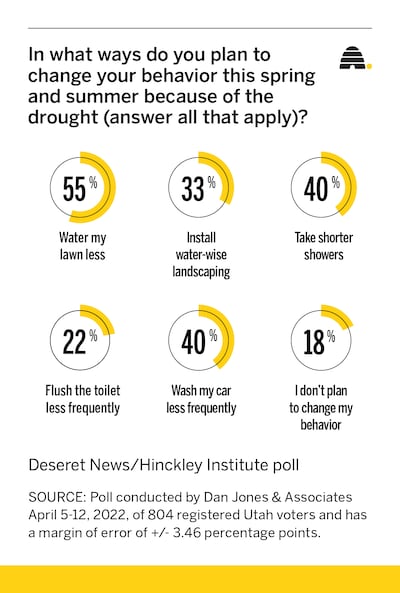The latest state report on Utah’s drought conditions reads like a horror novel.
Bad news creeps around every corner, waiting for dried out lawns, challenged drinking water supplies and fewer crops in the field.
But this isn’t fiction.
“Utah has been in drought eight of the last 10 years, and this year’s disappointing snowpack is not going to pull the state out of drought,” said Brian Steed, executive director of the Utah Department of Natural Resources.
“The recent snowstorms were beneficial. However, they added less than an inch of water to our snowpack. We are urging all Utahns to use water responsibly and to check with local water providers for potential water restrictions.”
A new Deseret News/Hinckley Institute of Politics poll shows Utahns, generally, do plan to do their part in the midst of what’s being called the worst drought in North America’s West in 12 centuries.
Consider that 99% of Utah is in severe drought, 28 of Utah’s largest 45 reservoirs are below 55% of available capacity, and of 95 measured streams, 51 are flowing below normal despite spring runoff. Across the state, eight streams are flowing at record low conditions, according to the deliverer of the bad news, the Utah Division of Water Resources.
So how will Utah residents step up to save Utah’s finite resource?
Among the options presented to 804 poll participants during the week of April 5-12, the No. 1 water-saving act among the six potential ways will be watering their lawns less, with 55% picking that as their top strategy.
The poll has a margin of error rate of plus or minus 3.46%.

Next on the list: taking shorter showers and washing the car less frequently (both 40%) and the installation of water-wise landscaping at 33%.
There are even some folks who agreed to flush their toilets less frequently, with 22% agreeing to use that option.
Despite aggressive campaigns by the Utah Division of Water Resources — slow the flow — as well as major water providers, counties and cities, 18% of people who participated in the poll say they have no plans to change their water habits this spring and summer.
“Wow,” said Michael Sanchez, a spokesman with the water division. “I think that just shows that we have a ways to go to target our messaging for folks who don’t think they need to conserve water.”
That attitude of no change may come with unsavory consequences.
Some irrigation companies will cut off users completely if they are caught violating time of day restrictions, watering on a day that is not allowed, or extending their allotted time for watering.
Some cities, too, are considering implementing tiered pricing for water — you pay more the more you use — rather than at a set rate that does not encourage water conservation.
The call to action to save water last year did produce measurable results, with people and institutions rising up to do their part.
However, conservation strategies did not stop a trio of Utah cities from running out of water last summer and this year. The situation has grown so dire for the Weber Basin Water Conservancy District, it bought water from another water provider.
While no announcement has been made yet by Gov. Spencer Cox, it’s anticipated that an emergency drought declaration awaits Utah this year.


 alt=Amy Joi O'Donoghue
alt=Amy Joi O'Donoghue